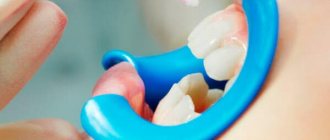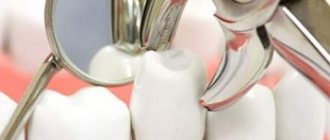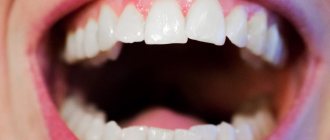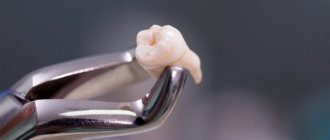Home / Articles / Teeth falling out - what to do
The absence of a tooth, especially the front one, always provokes a lot of problems. The main one is a decrease in a person’s self-esteem, because in the absence of a beautiful smile, everyone will avoid communication. At the same time, tooth loss can be accompanied by numerous physiological problems. The contours of the face may noticeably change, and insufficient chewing of food can even provoke disturbances in the functioning of the stomach, although even this is not the worst consequence.
Sign up for a free consultation >>
Why do teeth fall out
If your teeth begin to fall out, think about the reason for their loss. There are several common reasons why teeth fall out in humans:
Caries
Caries disease is accompanied by a violation of the mineralization of teeth, which ultimately destroys bone tissue in the oral cavity. Inside the tooth, the cavity gradually grows and becomes empty, which leads to acute sensitivity and food particles getting inside the teeth. Ignoring the symptoms of caries and unwillingness to consult a professional dentist ultimately leads to the fact that the tooth completely ceases to perform its function. The only solution in this case is to pull out the tooth.
It is possible to avoid caries by brushing your teeth properly and using toothpaste rich in fluoride. If even small holes appear in the teeth, it is recommended to immediately fill them in a specialized clinic.
Periodontitis
The first symptoms of the disease are bleeding in the gums. Next, an unpleasant odor appears in the oral cavity and a purulent process begins when pressure is applied to the gums. After some time, the affected tissues become completely incapacitated. Therefore, if your tooth falls out with blood, often the reason lies precisely in periodontitis.
Prevention of the disease in this case is quite simple: monitor the health of your gums and always visit the dentist in a timely manner, without waiting until the pathology becomes incurable. After each meal, try to brush your teeth for three minutes using special dental floss and toothpaste.
Chronic diseases
The reason why teeth fall out without pain and blood, and sometimes with them, can also be inflammatory processes as a result of chronic diseases. Common causes are hypertension, thyroid problems, diabetes, and respiratory problems. Often, aggressive methods of treating serious diseases, in particular chemotherapy, can provoke dental problems.
Negligent oral care, improper diet
It's no secret that citrus drinks can deplete enamel, which causes erosion. Gradually, this stimulates the development of caries and leads to the final loss of the tooth. A similar effect can occur if you carelessly eat nuts, crackers and other hard items. Clefts appear in the teeth, they become loose and subsequently fall out. Try to avoid eating excessively hot and cold foods.
Tobacco products, drugs
About a third of patients who systematically lose teeth are people with bad habits, in particular, heavy smokers. It is reliably known that drugs and tobacco not only worsen the color of teeth, but can also be the reason why molars fall out.
Our clinic
Until recently, the prospect of wearing them was perceived by people with horror: they could not eat properly, nor kiss. After all, the prosthesis, which is fixed in the mouth by vacuum, can suddenly fall off, exposing indecently bare jaws. Of course, you can use fixing glue, but this is not the best way out.
There are also more reliable partially removable structures that can be installed using special clasps (hooks). But they are only suitable if at least some of your own teeth remain in the mouth. True, when installing such structures, the aesthetics, of course, suffer noticeably - the metal hooks are visible. Although if the prosthesis is attached to crowns, then micro-locks can be used as fixation. Unlike clasps, they are not so noticeable.
And yet, removable or partially removable structures have too many disadvantages. But recently, fundamentally new removable dentures have been created from thermoactive plastic, which are exceptionally light, comfortable and durable. Unlike the old ones, which were stiff, thick and uncomfortable, which patients often carried in their pockets rather than in their mouths, the new designs, created from a special thermosetting plastic, are flexible and light as a feather.
People quickly get used to such dentures, as if they were their own teeth. What is very unusual and pleasant is that these designs do not need to be placed in a glass overnight, like their previous versions. You only need to take them off in the morning and evening to brush your teeth. Flexibility makes these removable dentures more resistant to cracks and more durable.
A metal-ceramic crown is installed on the anterior units. It belongs to one of the types of dentures. This product can completely replace natural front teeth. The crown is made of metal and ceramic. Its frame is highly durable, and the ceramic coating gives it high aesthetics.
For this purpose, veneers and lumineers are not used; it is best to install prostheses made of metal-free ceramics. When implanting lower and upper units, it is very often necessary to perform bone grafting, since there is a high probability of tissue atrophy.
The doctor must prescribe treatment for the patient. Implants are only installed if gum disease is completely cured. If the stage of long-term remission has begun, then a removable denture or bridge is installed.
In this case, minimal damage is caused to the gum, but adjacent units are ground down.
There are several indications for which it is necessary to restore the anterior units with a crown or prostheses:
- Skol.
- Cracks.
- Caries.
- Malocclusion.
- Improving the aesthetic appearance of a smile.
- Pronounced abrasion of enamel.
- One or more units are missing.
- Consequences of incorrect prosthetics.
We suggest you read: What to do with a baby tooth that has fallen out. What to do with a lost baby tooth
Ceramic and metal-ceramic crowns for anterior units must, above all, be durable and aesthetically pleasing. Yellow and steel crowns are rare techniques that are currently practically not used.
An important role in improving the aesthetic appearance of a smile is played by the patient’s gender and social status, as well as the type of smile - open or closed. From an anthropological point of view, women's teeth should have rounded edges, and men should have pronounced teeth with sharp edges. If a patient is focusing on professional development, the dentist may make the canines slightly larger—research shows that taller canines make people more confident.
Anterior dentures are an important factor in aesthetics because the teeth support the lips, cheeks, and other oral tissues.
A metal-ceramic or plastic crown is installed only after root canal treatment.
A currently popular alternative to dentures is implantation. Implantation can be performed if the patient has one lost tooth or all 32. Unlike a crown, the implant is not attached to the damaged or adjacent organ and is mounted into the jaw bone itself.
The task of modern dentists and dental technicians is not only to restore the functions of a lost organ, but to make the prosthesis beautiful and natural.
Modern requirements for prostheses (crowns):
- Prostheses must be biologically compatible. Currently this factor is very important. Only ceramic crowns do not cause allergic reactions.
- The crown should be aesthetic and look good. A good prosthesis should look exactly like a normal organ. Metal-free crowns have a natural color. It is possible to preserve the anatomical shape of an organ using metal-ceramic structures. But in this case, the neighboring units will be damaged, since the dentist will have to grind them down. Moreover, healthy teeth are translucent. The metal used in the dental structure makes the artificial denture appear opaque.
- After having metal ceramics installed, many people see darkened gums or a metallic edge around the organ. Ceramic structures do not have these disadvantages, since they do not contain metal. Metal-free crowns do not cause gum injury, periodontitis or gingivitis.
- Ceramic crowns have the same thermal dilatation as healthy teeth. A person does not feel discomfort while eating or drinking cold or hot. Ceramic crowns will last longer.
- Metal structures can cause allergies and idiosyncrasies, while ceramics are safer.
- Ceramic crowns are lightweight. In cases where multiple units need to be restored, metal crowns may be too heavy.
- There is another advantage of prosthetics using ceramics - fixation occurs with glue. It turns the artificial prosthesis and the root into a single whole.
Tooth loss in children
When (at what age) do baby teeth fall out? Typically, the first milk teeth fall out in children aged 6-7 years, but deviations from the timing are possible based on the individual characteristics of the body. Although baby teeth erupt at the age of 6 months, their formation begins in the uterine period during the mother’s pregnancy. With the birth of a child, the formation of the rudiments of permanent teeth begins, which is why it is important to monitor the health of the milk teeth, because infection with caries can easily harm the rudiments of permanent teeth.
Dentists' recommendations
Before replacing the upper and lower teeth with prosthetics, the dentist must carefully examine the patient in the clinic, draw up a treatment plan and present him with possible treatment alternatives.
First of all, the concept of minimal invasion should prevail in organ reconstruction. When making prosthetics, the doctor should try to preserve as much natural and healthy tissue as possible. Modern dental clinics offer their clients to abandon radical polishing of teeth for metal-ceramic crowns and to have prosthetics using strong and aesthetic all-ceramic inlays, onlays, veneers, lumineers or partial crowns.
Do teeth fall out on their own?
Yes, they fall out if they are dairy. In this case, changing teeth can be accompanied in children by acute painful sensations, swelling of the gums and sensitivity of the enamel, and in some cases even itching. If you experience these symptoms, it is important to seek the advice of a professional dentist. At the same time, while waiting to see which tooth falls out first, you should not forget about the child’s adequate nutrition so that the body and teeth in particular continue to receive all the necessary vitamins and microelements.
When a baby tooth falls out, the wound may continue to bleed for 5-10 minutes. Simply give your child a sterile gauze or cotton swab to bite on the area where the baby tooth has fallen out. If bleeding continues for a long time, be sure to take your baby to the pediatrician to check blood clotting. The help of a dentist may also be needed when baby teeth complicate the eruption of permanent teeth. In this case, the teeth are forcibly removed.
What to do if teeth fall out
Many patients are interested in the question of what to do if a tooth falls out at home. Of course, in a number of such cases no additional measures are required - for example, if a tooth falls out in the side of the jaw, which is not visible when communicating with other people. However, the need to restore a lost tooth may not only become necessary if the tooth falls out from the front. Since the load on the jaw is unevenly distributed, this can ultimately lead to jawbone atrophy. The only way out of the current conditions is to install a dental implant.
If a patient has lost a front tooth, or if it was deliberately removed, it is possible to restore a beautiful smile with the help of a bridge. A similar solution is appropriate if the permanent lower tooth falls out, which is subject to the greatest load when eating food. The use of a bridge is also appropriate if false teeth, rather than permanent ones, have fallen out.
Photo after restoration of the dentition using implants
There are several technologies for dental prosthetics for partial loss. Today, the best way to restore teeth is implantation. This method is the most reliable (modern implants take root in 98-99% of cases, service life is more than 20 years and even a lifetime), the most aesthetic, functional and comfortable to use, because implants imitate the root of a tooth. It is also very important that during implantation there is no need to grind down adjacent healthy teeth.
The only thing better than implantation is your own tooth!
We suggest you familiarize yourself with: Korean or Israeli implants. What to choose?
When a front molar is lost, implantation with immediate loading is often performed. With its help, the dentist immediately after installing the implant, without waiting for its osseointegration, installs a temporary crown that covers the aesthetic defect. The temporary crown is removed from the bite and is often bonded to adjacent teeth.
After 2-6 months, the temporary crown is replaced with a permanent one. Immediate loading is carried out for aesthetic, not medical reasons. When a tooth is 100% subject to extraction (for example, with a longitudinal root fracture), but has not yet been removed, it is possible to perform an operation to remove the tooth and install an implant at the same time. In this case, the period of complete treatment is reduced by 3-4 months, and the cost is slightly reduced.
If the front teeth are destroyed by more than 60%, in such cases it is necessary to make crowns on the front teeth. Before this, it is necessary to restore the damaged teeth with core inlays. The most aesthetic core inlays for front teeth are made from zirconium dioxide. This is done so that the standard metal stump inlay does not show through the thin mucous membrane of the gums and does not make the gum blue or gray in the area of the neck of the front tooth.
- Zirconium
- Ceramic
- Metal-ceramic
The best aesthetic results are achieved with all-ceramic crowns. If you have problems with clenching and grinding your teeth while sleeping, it is better to choose anterior zirconia crowns. The most budget option, metal-ceramic crowns for the front teeth.
Why does a filling fall out?
Filling loss is an equally common problem with the human oral cavity. This also creates an uncomfortable feeling, especially when eating: the chewing process becomes more difficult, and pain symptoms begin. If a filling has fallen out of your tooth, be sure to seek help from a professional dentist in your city.
There are a wide variety of reasons why a filling may suddenly fall out of a tooth. The most common among them is the use of low-quality materials in the filling, as well as improper shrinkage of the filling inside the tooth . This can cause a small hole to form between the tooth and the filling, which becomes clogged with food and becomes a breeding ground for bacteria. Often this situation is complicated by the appearance of secondary caries.
Often the loss of a filling is associated with the expiration of its service life . On average, based on installation technology and manufacturing material, a filling lasts about 7 years. Regular visits to the dental clinic will help determine when the need to replace the filling arises.
Other reasons why fillings may fall out are a lot of pressure on the tooth (in particular, due to strong impacts or cracking of a nut), as well as failure to maintain proper oral hygiene.
The meaning of dreams
A dream in which a person lost a tooth is interpreted in a special way. Pay attention to the presence of blood. If one or even all the incisors, canines, molars fall out, without blood, they await the death of an acquaintance, friend, neighbor.
If the gum from which a tooth fell out in a dream produces blood, the death of a blood relative is expected. At the same time, it is impossible to determine in advance who will die.
When a fragment of a tooth simply breaks off in a dream, it is advised to take a break. This happens in moments of nervous, physical, mental overstrain, when the energy shell becomes thinner.
What to do if a filling falls out
Losing a filling is a common problem, but does not have any negative consequences other than the pain associated with the reopened nerve. If a temporary filling falls out at the most inopportune moment, try to contact your dentist as soon as possible. Given that the tooth cavity is opening up again, delaying the process of installing another filling can lead to aggravation of the problem, especially if food particles get into the tooth cavity.
Before starting treatment for a temporary filling that falls out, dentists determine the reason for the loss. Based on specific conditions, a certain material is selected, and treatment occurs using a certain technology. During the treatment, the remains of the previous filling are eliminated, the oral cavity is thoroughly processed, and then the damaged tooth is restored.
Until the dentist restores the lost filling and numbs the pain, the only possible measure the patient can take is not to place excessive stress on the damaged tooth. It is advisable to chew food on the other side of the jaw, and when brushing your teeth, treat the damaged area more carefully. It is also recommended to rinse your mouth more often to protect the damaged tooth from possible penetration of food debris with microbes and bacteria into it.
Statistics confirm that about 39% of people who complain about dental problems try to avoid visiting doctors. Fear of instruments and drills is quite justified, as is fear of possible discomfort when treating teeth and gums. However, it is precisely those patients who undergo systematic examination by dentists who avoid the biggest troubles throughout their lives. These include tooth loss.
Sign up for a free consultation >>
View prices
Making an appointment with a dentist
Preparation for prosthetics
New job, Kirill 55 years old.
It is possible to avoid serious dental problems if you take proper care of your oral cavity and know about suitable ways to prevent tooth loss. In this article, we will tell you about the causes of tooth loss, including how to avoid discomfort and improve your oral health.
Before the era of implantation, this was the most popular and virtually uncontested method of aesthetic prosthetics, but times and the quality of medicine are changing...
The technology of prosthetics with a bridge is as follows: let’s say one tooth is lost, the teeth adjacent to the missing one are designated as supporting teeth (bridge supports). The teeth are prepared - depulped, treated if necessary, and ground down for a crown. The structure, consisting of three crowns, is fixed on the supporting teeth, incl.
and a lost tooth that does not have its own support. Modern preparation methods make it possible in some cases, when using a zirconium dioxide frame, not to depulpate the supporting teeth, but in some cases, after some time, patients may complain of increased sensitivity, and the nerve has to be removed.
The method of prosthetics with bridges is considered more affordable, however, as you will see below, when filling a single defect in the dentition, this statement is no longer so obvious.
The time for installing a bridge prosthesis (1-2 weeks) is significantly less than for treatment with implantation, but it has many disadvantages: the service life of a bridge prosthesis is 10-15 years, supporting teeth, which are often healthy, are ground down and injured when chewing or biting they experience increased stress on several teeth.
There is no clear and uniform solution for all cases of restoration of one molar. Each person has unique characteristics, and implants and crowns have different costs. Therefore, the calculations below for tooth restoration using the implantation method and using a bridge are approximate. To receive a full consultation with a dentist, we invite you to our clinic.
In this case, it is best to use dental implants. An implant is a dental procedure in which a metal base is placed into the jawbone (usually a screw) and the implant acts as a support or anchor for a new artificial tooth.
Dental implants are used to replace units when they are severely damaged and have no hope of survival. Over time, the implant or screw integrates into the jawbone and remains a strong support for artificial dentures (a process known as osseointegration).
Average prices for prosthetics of the anterior upper units:
- Installation of veneers - 1500-50000 rubles.
- Installation of lumineers - 30,000-45,000 rubles.
- Installation of composite veneers - 1500-2500 rubles.
- Clasp implant (price for one implant) - 30,000-80,000 rubles.
Video review of a patient after basal implantation in dentistry with innovative technologies Smile-at-Once
- Temporary
- Permanent
- Removable
- Fixed
When the cutting edges of the front teeth are chipped, or when the front teeth are unfolded and dark, dentists use veneers, which are ceramic overlays, 0.3 to 1 mm thick, of different colors and degrees of dullness. Veneers are fixed to the outside using bond and adhesives. Recently, dentists have been using veneers made from lithium desilicate glass ceramics by pressing and high-temperature firing.











